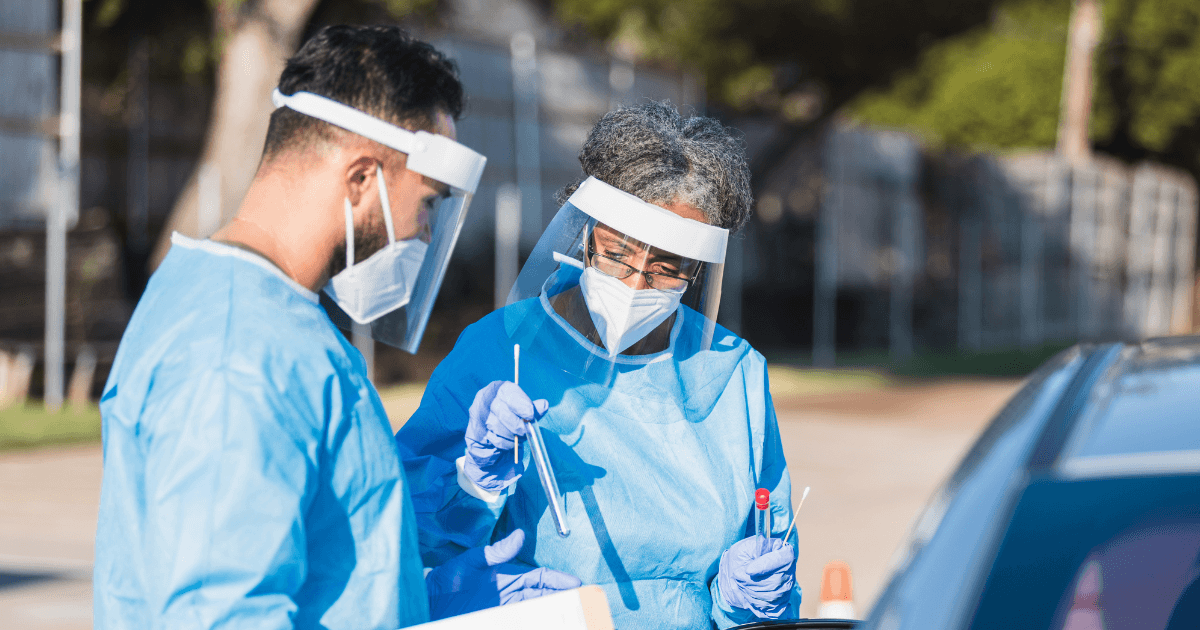A Close Look at the COVID-19 Impact on Healthcare in Local Communities and Beyond

8 Minutes

Team Curative

Nov 16, 2022
The COVID-19 Impact on Health Care for Employees, Community Members, and Providers Alike
No matter the world’s economic state, one thing is certain—there will always be employment opportunities available in health care. Today, there continues to be a high demand for medical professionals across every field and sector of health care. Large-scale crises, like the pandemic, typically result in an influx of health care opportunities, both for employees working in the field and for people who need access to medical help in their communities. Increased demand came at a time when many in health care were already burnt out and switching occupations. Although the health care industry did (and still does) house an abundance of talent, the rising health needs in the wake of COVID-19 have made it difficult for employers to balance need with capacity. This is one catalyst driving the upswing in community health offerings and local-level care services, which can give employers a better idea of how to hire in a POST-COVID-19 world.
Over the last two years, health care employment rates have seen a significant drop. Currently (as of November 2022), the number of Americans employed in health care is 0.5% lower than in February of 2020, when employment in this sector was last on the rise. Some medical fields are more affected than others, with nursing and elder care employment rates falling below pre-pandemic levels.
COVID-19 has certainly had an impact on the way communities access localized health care, which has inspired new methods of employment in small community health care centers. More patients are scheduling telehealth appointments and relying on fast, affordable, and efficient medical delivery services to help them access their medical needs from home. Health care employers can see how local communities lead by example, encouraging them to incorporate new health benefits systems to attract and retain new employees in a field that is currently inundated with recruiting needs in a time of global crisis.
How Health Care Employment Rates Shifted Throughout COVID-19
COVID-19 has had some interesting effects on the health care industry in terms of employment and turnover rates. Before the pandemic, the health care sector was just starting to see an increase in the number of people quitting their jobs or changing their occupations outside of health care. The start of COVID-19 spurred an attempt to put a freeze on those high turnover rates, but it was still not enough to combat the new wave of health care needs— and subsequent job openings across the board— that arose rapidly at the height of the crisis. According to the Job Opportunity & Labor Survey, job openings in health care are 80% higher than they were in pre-pandemic days.
An alarmingly high turnover rate still exists across health care services, with unemployment rates rising. However, those who still remain working in the health care sector are seeing steady wage increases. It is evident that employers want to create a more workable environment for their employees, who have to contend with high rates of exposure risk along with a lack of personnel and vital resources.
That is why health care employers and providers are looking at community health efforts that are transforming localized care in many ways, using new systems of communication and delivery to offer better health care systems for all.
How Localized Community Health is Leading the Charge in Post-COVID-19 health care
Local community health centers were massively impacted by COVID-19. Before the pandemic, these centers existed as places where patients could receive triage, emergency treatment, quick tests, and other medical services that can help them unburden the hospitals. During COVID-19, these centers quickly became much more than that. Nearly 90% of all community health centers in the U.S. immediately started offering COVID-19 tests, with the majority of them operating solely for that reason.
The flip side of such a rapid change in the delivery of community health is the unforeseen closure of certain health care sites. While some federally-funded health care centers were able to convert into testing sites, others had to temporarily close to mitigate the upsurge in costs. This made it difficult for folks in those local areas to access that same type of care without traveling out of their way.
Stay-at-home orders facilitated the emergence of telehealth as a valid and acceptable way to receive health care safely. This also lifted burdens from those who could not access medical services outside of their communities. After quarantine orders were lifted and in-person medical visits became a possibility for many more patients, there was still a trending preference towards virtual appointments that persists today.
From the ground up, patients and providers alike created new methods of delivering health care services to families who previously struggled to access care. Communities large and small can now receive safe, reliable, and informative COVID-19 testing services at one of the thousands of kiosks and drive-through locations that make COVID-19 care easier than ever.
The way health industries responded to the COVID-19 crisis is nothing short of momentous. An important shift that people noticed throughout the first two years of the pandemic is that health care, as a whole, was more responsive to local and community needs. One Journal of The Society of Laparoscopic & Robotic Surgeons author named COVID-19 the "deadliest medical challenge since the Spanish Flu in 1918". While grave, COVID-19 sparked a change towards compassion and empathy, proving how these two things can transform the way health care is geared to handle crises.
Health care Access and Employment Post-COVID-19
It’s no secret that the health care industry has changed dramatically since the beginning of the pandemic, marking COVID-19 one of the most transformative times for the entire economy of medicine and health care services. Health care providers are starting to understand that the needs of the individual continue to change, and these changes are reflected at the community level.
There is a larger need for simplified and accessible health plans at both local and national levels. Patients living in such an unpredictable time need to rely on predictable in-network rates. COVID-19 has inspired the next generation of health insurance as new health plans place a larger focus on quality, transparency, and personalization.
This noticeable shift spans larger than health insurance; clinics large and small are re-prioritizing the attention given to outpatient health. By opening hundreds of points of care across the nation, testers and providers can more easily reach the families who require care the most. This continued trend towards compassion, along with increased reliability on virtual tech, go hand in hand in a post-COVID-19 world. Communities are finding it easier to access what they need, serving as a shining example to health care organizations looking to increase health benefits and wage offerings for future medical employees. There is hope that employment and employee retention rates will continue to grow.
The COVID-19 Impact on Health Industry Standards and Expectations for the Future
It is likely that public and private health care sectors will continue to mandate safe public practices based on CDC and WHO guidelines. If you are returning to work or starting work in health care for the first time, you are entering the sector at an interesting time in history. You may see fluctuating employment rates and shifting health care needs firsthand. It’s important to get set up with an affordable, no copay health plan through your employer or through a reliable community care center so you don’t have to deal with burnout or a lack of support.
COVID-19 is still present, and it will remain for the foreseeable future. You can protect yourself and your local peers as a high-risk employee by asking your employer about Curative’s no copay, no deductible health insurance plan. Our in-network care options range from virtual urgent care to personalized medical treatments that always have your best health in mind. Connect with local doctors you can trust and feel at ease about your health care access in an ever-changing, post-pandemic world.
NOT MEDICAL ADVICE: The information provided on the blog is not a substitute for the advice of a personal physician or other qualified health care professional and does not constitute a diagnosis or professional treatment recommendation. Always seek the advice of a physician or other qualified health care professional with any questions regarding medical symptoms or a medical condition. Never disregard professional medical advice or delay in seeking it because of something you have read on the Site. Curative hereby disclaims any and all liability to any party for any direct, indirect, implied, punitive, special, incidental or other consequential damages arising directly or indirectly from any use of the content, which is provided as is, and without warranties.
NOT LEGAL ADVICE: The information provided on this blog does not, and is not intended to, constitute legal advice; instead, all information, content, and materials available on this site are for general informational purposes only. Information on this website may not constitute the most up-to-date legal or other information.
THIRD PARTY LINKS: This blog contains links to other third-party websites. Such links are only for the convenience of the reader, user or browser; Curative and its affiliates do not recommend or endorse the contents of the third-party sites.
VIEWS EXPRESSED: The views expressed at, or through, this blog are those of the individual authors writing in their individual capacities only – not those of Curative and its affiliates. All liability with respect to actions taken or not taken based on the contents of this site are hereby expressly disclaimed. The content on this blog is provided “as is;” no representations are made that the content is error-free.
Sign up for our Newsletter
Table of Contents
The COVID-19 Impact on Health Care for Employees, Community Members, and Providers Alike
How Health Care Employment Rates Shifted Throughout COVID-19
How Localized Community Health is Leading the Charge in Post-COVID-19 health care
Health care Access and Employment Post-COVID-19
The COVID-19 Impact on Health Industry Standards and Expectations for the Future








